When I was a little girl, I used to dream of mermaids. I would lie in bed, fantasizing about life in the ocean and what it would be like to swim among the kelp and fish in their underwater world. Little did I know that mermaids existed all along on the small island of Jeju, off the southern coast of South Korea. Although they are not mythical mermaid princesses, they are a community of female free-divers called Haenyeo—Sea Women.

My first encounter with the Haenyeo was through their song. I was hiking in the Seongsan crater on Jeju, an island off the southern coast of South Korea, when I wandered down a winding cliff path to the waterfront. On the rocky beach, an empty seaside restaurant offered seafood to absent crowds. It was obvious that Covid had taken a toll on the local tourism industry. Then the sound of singing came from a shack next to the restaurant, and filled the bay. A few minutes later five women emerged, probably in their late 50s and 60s, wearing brightly-coloured woolen underwear, wetsuit pants, and rubber moccasins. They continued to sing, dance, and laugh while simultaneously helping each other into their remaining diving gear. I later learned that the Haenyeo pray to Jamsugut, the goddess of the sea, before each dive. Through the shamanistic ritual of song and dance they ask for safety while diving and a plentiful catch.
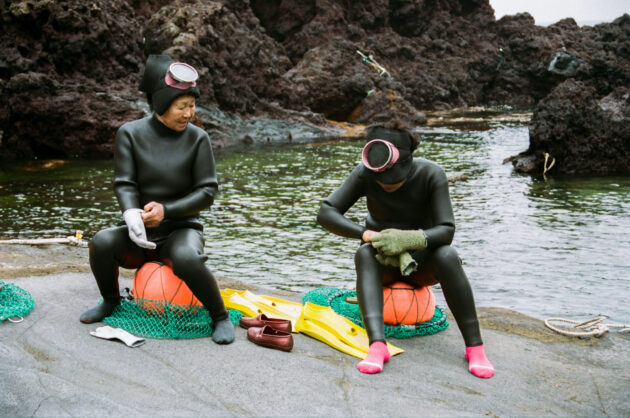
The Haenyeo are a community of female free-divers living and working on Jeju. Due to younger women opting for different career paths, today they are mostly older women, many well into their golden years. They dive as deep as 10 meters below the surface without the help of air tanks or modern diving equipment, with little insulation from the cold South China Sea. Yet, as I watched them dive, they seemed oblivious to the cold waters and cool ocean breeze. If anything, they seemed to be enjoying themselves, and their laughter was contagious to everyone on the beach.
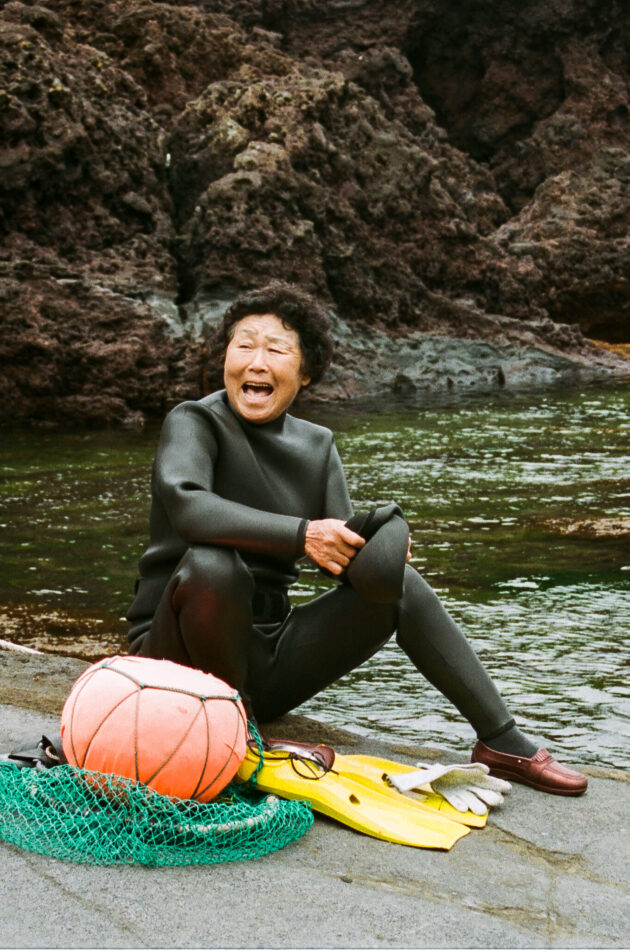
The first records of Haenyeo come from 1629, and for 350 years they used to dive wearing cotton clothes called mulsojungi. It was not until the 1970s that the Haenyeo started wearing the rubber wetsuits they wear today. During dives, they gather shellfish such as abalone and sea urchins, kelp and other sea creatures to sell for food, using only a knife or their bare hands. While I was sitting on the beach, one of the divers resurfaced and delivered an octopus to a female helper on shore who showed it off to a growing crowd of spectators. Later they all brought their kelp-filled nets and emptied them out on the rocky shore to dry.
The diving season on Jeju is short; the women dive for only about 90 days a year. They descend below the surface for minutes at a time, attached to an orange buoy at the surface, and make a whistling sound when they resurface to communicate their whereabouts to the other divers. Known as “Mothers of the Sea” and “Warriors against the Sea,” they are traditionally categorized according to three levels of experience—the sanggun being the most experienced, followed by hagun and junggun. More accomplished divers offer their guidance to the others and teach the younger divers the vital breathing technique, called sumbisori. The Haenyeo are lifetime companions. Not only do they share everything they gather evenly between themselves, but they support each other through life’s challenges such as pregnancies, illnesses, and any crises.
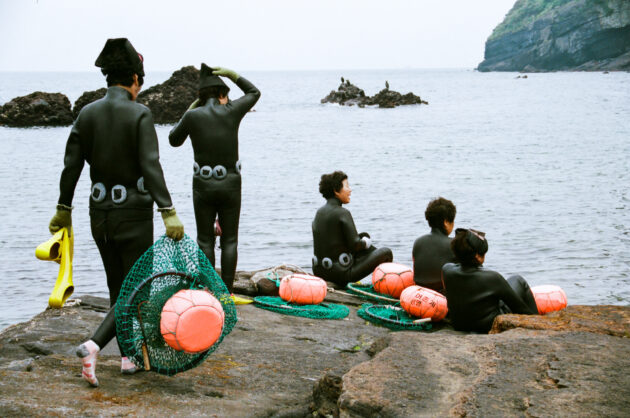
The Haenyeo have an elevated social status in an otherwise patriarchal South Korea, but it is unclear why free-diving became a female-dominated profession on Jeju. Explanations range from men dying in deep-sea fishing accidents or wars, to physiological reasons, for example women’s fat reserves supposedly making them more resistant to cold water. Historically, so many families depended on the income of the Haenyeo that a semi-matriarchal society developed in Jeju. It was not unheard of for women to be the main breadwinners, while men would stay home and take care of the children. One way in which non-standard gender roles were manifested was through the payment of dowry to the family of the bride, instead of the groom. Unlike families in mainland South Korea, families on Jeju would wish for the birth of baby girls rather than boys.
In recent years, Haenyeo culture has declined due to increased industrialization, new education and work opportunities for girls, and environmental degradation of Jeju Island. In 2016, the Haenyeo culture was assigned to the list of UNESCO Intangible Cultural Heritage due to its unique history and the rapid decline of female divers. Its elevated status due to the UNESCO listing has resulted in a new tourist industry, and increased protection and funding of the women in the industry and the natural environment of the island. [The government provides free healthcare, and the necessary diving equipment, and has opened a diving school and museum]. However, while this new heritage status has brought benefits for the community, it has also made the women into living artifacts who perform their work for tourist audiences. There are now places where you can pay to watch the women dive, and buy their catch.
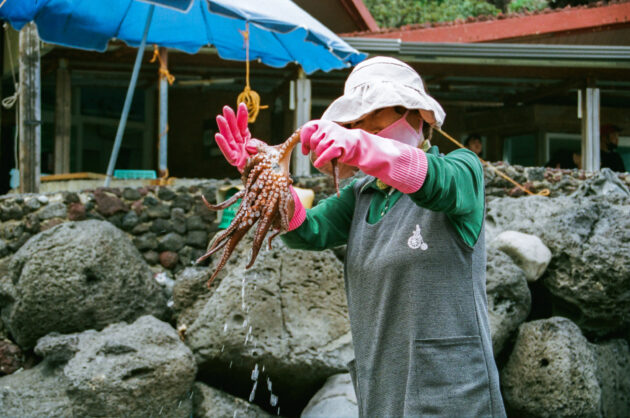
A side-effect of “Unescoization,” a term coined by anthropologist David Berliner, is the development of intense tourism, which can lead to traditions being staged or inaccurately represented. A culture becomes a product to be consumed by a global audience, and the everyday life of the local population becomes focused on delivering a so-called “authentic experience.” The route between Seoul and Jeju was the busiest flight route in the world in 2019, with over 17 million seats sold on 85,000 flights. While there are many attractions on Jeju other than the Haenyeo, what will this level of tourism do to the culture and natural environment of this relatively small island over time? Increased tourism on the island has already caused problems with traffic, littering of beaches and national parks, and water depletion. In addition, despite efforts to preserve the Haenyeo culture, the number of female divers are still declining. At its peak there were 23,000 women working in the industry, while today there are roughly 4,500 divers of which only 2,500 work full-time. As of 2014, over 98% of the Haenyeo were more than 50 years old.
As I sat by the waterfront, watching the women dive, I couldn’t help but feel uplifted and inspired. It is rare to see such strong companionship among women and to witness a culture that values the work of older women to the extent that South Korea does with the Haenyeo.
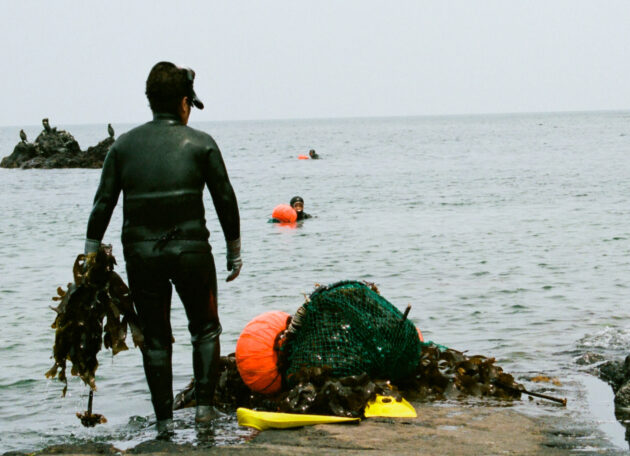
They are extraordinary women, and their commitment to each other, their love for the sea, and their fearlessness gave me courage. I realised the Haenyeo are better than the mermaids I dreamt of as a child. They are real, hardworking, badass women who defy social expectations. If you ever hear a child speaking of mermaids, tell them the tale of the Sea Women of Jeju.
Website: https://sarah-fuchs.com/
Instagram: https://www.instagram.com/sarah.fuchs/

Author
Sarah Fuchs
Author's Bio
Sarah Fuchs is a documentary and travel photographer. Born in Norway, she has spent her adult life living in the Netherlands, Singapore and South Korea, and working across the globe. She is passionate about telling human stories, often focusing on women, minorities, and issues related to climate change.
Credits
Photos by author


